
Microsleeps are one of the most dangerous effects of sleep deprivation. But what is microsleeping and what’s going on in your brain when it happens?
You have a blank stare; your eyelids start to droop. You’re out for five to 10 seconds before waking up with a jolt. Microsleeps don’t sound too bad initially, but when they happen behind the wheel and you begin drowsy driving, that’s when the problems start to mount. Read on to find out more about microsleeps and what you can do to prevent them.
What are microsleeps?
Microsleeps are brief, unintentional episodes of sleep lasting for a couple of seconds. They can occur pretty much anywhere, whether you’re in a meeting, watching TV, or behind the wheel of your car. So, what’s actually happening in your brain when microsleeps happen? Basically, it’s all to do with fatigue. When your body isn’t getting enough sleep, your brain will eventually just shut down. So, in a sense, microsleeps is that they are sleeps that your brain forces you to take.
We don’t have a clear picture of the inner workings of your brain during a microsleep, but one study has indicated that parts of your brain remain active while others fall asleep. According to this study from the University of Wisconsin, some of your nerve cells will essentially go “offline” while the rest of your brain sticks it out. Another study found that during episodes of microsleep, there’s increased activity from the areas of your brain that control attention and sensory processing, while your thalamus—the area of the brain that controls sleep—sees a reduction of activity.
What are the causes of microsleeps?
Microsleeping is caused by lack of sleep. If you suffer from insomnia, narcolepsy, obstructive sleep apnea, or you’re not getting enough sleep for other reasons, you may be more prone to microsleeps. In fact, frequent microsleeps may be a symptom of undiagnosed obstructive sleep apnea. If you’re getting enough sleep, but you keep experiencing microsleeping, it may be an indication that you should schedule an appointment with a doctor.
What are the most notable microsleep symptoms?
A few behavioral indicators may be associated with this condition. These include:
- Blank stares
- Drooping head
- Lack of response to information
- Sudden body jerks
- Slow blinking
- The inability to remember the past couple of minutes
There are also warning signs that may indicate that a microsleep is imminent. If you catch yourself yawning excessively, constantly blinking in an effort to stay awake, or find it difficult to keep your eyes open, you may be about to experience a microsleep.
What is the health impact of microsleeping?
Microsleeping by itself isn’t damaging to your health, although it does suggest that you aren’t getting enough sleep, which can cause a wide range of health problems. But when microsleeps occur in dangerous environments, such as when you’re driving, there’s a real risk of causing harm to yourself or others. It’s part of the whole drowsy driving problem, which the U.S. National Highway Traffic Safety Administration (NHTSA) claims is responsible for around 100,000 motor vehicle crashes and over 1,500 deaths every year.
How can I prevent microsleeping?
Because microsleeping is often the direct result of lack of sleep, the most obvious way that you can prevent episodes of microsleep is to improve the amount and the quality of the sleep that you’re getting. That means that you’ll need to get around 7 to 9 hours every night. Taking breaks in between activities, as well as a couple of naps if you have time, is another great way to stay rested throughout the day. In addition, you can take a couple of extra precautions, such as playing music or rolling down the windows, but that’s no replacement for a solid night of Zzzs!
Bottom line: microsleeps can be seriously dangerous, particularly when it comes to drowsy driving, but a couple of microbreaks every day—plus a healthy night’s sleep—can reduce your risk.



